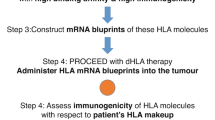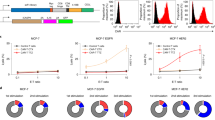Abstract
The immunogenicity of murine leukaemias induced by chemical carcinogens or irradiation in C57Bl or (C57Bl times DBA2) F1 hybrid mice has been studied in vivo by transplantation and in vitro by indirect membrane immunofluorescence (IF) using syngeneic immune or allogeneic immune antisera. Two of 5 leukaemias tested for immunogenicity by assessment of the capacity of syngeneic mice specifically immunized with irradiated (3 Krad) cells to reject small challenge inocula (10(3)-10(4) cells) displayed weak neoantigenicity while 3 were non-immunogenic by this criterion. Antibodies directed against cell-surface antigens of the immunizing cells of 7 leukaemias were not detectable by immunofluorescence tests using sera from the respective immunized mice. H-2 histocompatibility antigens readily identified on normal lymphoid cells using reference Balb/c anti-C57Bl (H-2d anti-H-2b) alloantisera could neither be detected on the majority of transplanted leukaemias nor on 9 primary leukaemias in C57Bl mice induced by N-butyl-N-nitrosourea (BNU). Two of the transplanted leukaemias showed greatly diminished capacity for absorption of alloantibody compared with normal spleen cells. Transplantation to H-2 different recipients, in which the leukaemic cells were invariably rejected, generated a strong humoral antibody response, which was demonstrable against normal lymphoid cells. Failure to demonstrate significant antibody binding by indirect immunofluroescence tests with immune sera, or by absorption, is presented as evidency that H-2 antigen expression is substantially modified on BNU induced leukaemia cells. These findings have implications for the detection of tumour neoantigens on chemically induced leukaemias.
This is a preview of subscription content, access via your institution
Access options
Subscribe to this journal
Receive 24 print issues and online access
$259.00 per year
only $10.79 per issue
Buy this article
- Purchase on Springer Link
- Instant access to full article PDF
Prices may be subject to local taxes which are calculated during checkout
Similar content being viewed by others
Additional information
Supported by grants from the Medical Research Council and the Cancer Research Campaign.
Rights and permissions
About this article
Cite this article
Birch, J., Moore, M. & Craig, A. Cell surface antigen expression on chemically induced murine leukaemias. Br J Cancer 31, 630–640 (1975). https://doi.org/10.1038/bjc.1975.109
Issue Date:
DOI: https://doi.org/10.1038/bjc.1975.109
This article is cited by
-
T- and B-cell determination in various lymphoid tissues of mice during N-nitrosobutylurea (NBU) leukemogenesis
Journal of Cancer Research and Clinical Oncology (1981)



